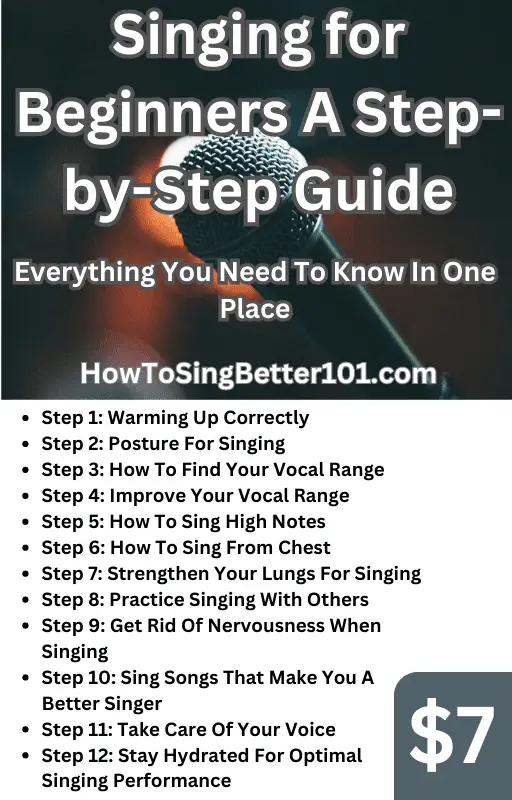Most singers do not have too much vibrato in their voice, but for those who do it can be a really frustrating journey to get rid of it. It is not that these singers do not know how to use their vibrato, but they do not know how to control it effectively, hopefully, my article will shed some light on the problem.
Excessive vibrato, often referred to as a wobble, is characterized by a slow and wide oscillation of pitch. It typically occurs when there is a lack of resistance to the airflow, causing the vocal folds to become slack. As a result, the voice may sound overweighted or overblown, and the overall vocal production is compromised. Achieving a controlled and balanced vibrato is essential for a pleasing vocal tone. By developing proper breath support and vocal technique, singers can work towards achieving a more controlled vibrato, improving the overall quality and stability of their voice.
If you want to enhance your singing and speaking voice then my personal recommendation is to use a natural vocal booster that also soothes and relieves hoarseness Click here to check it out on Amazon.com
A lot of singers really struggle with their vibrato voice, most of them do not have nearly enough power to make the extent of the vibrato last enough so they will cut short their vibrato sound abruptly. This not only sounds extremely bad but it is oftentimes considered fairly amateurish. While there are plenty of people whose main goal is to have enough power to vibrato sing, on the other hand, there are singers who go overboard with their vibrato singing, and simply put they have too much vibrato in their voice.
As for any singing voice, there should be a balance, and this is the same for your vibrato voice. Imagine yourself singing in such a high pitch that you will make all the neighborhood cats run away, this is kind of far-fetched but it is similar to having too much vibrato in your voice. While most singers would want to increase their vibrato, there are some who will want to decrease it as they are using their vibrato voice way too much.
If you are an older singer you might even find that you have something called a vocal wobble, while some will argue that this is because of incorrect use of vibrato voice, on the other hand, some studies have shown that singers who use their falsetto voice will develop this vocal wobble later down their lives. While some might say that the vocal wobble isn’t the end of any singer’s career, I have to agree as there are a lot of singing styles that have adopted singers who do have this wobbly voice.
The problem is that not a lot of beginner singers know how to correctly use their vibrato voice, or they are simply not able to control it. Oftentimes they either underuse or overuse their vibrato voice. Most singers who have problems with their vibrato voice often also use their falsetto voice for singing, although some experts would say that the term falsetto doesn’t apply to females, but on the other hand, there have been numerous studies showing that it exists. If you are a female singer having too much vibrato in your voice then my recommendation is to read my recent article How to sing falsetto female? ( In 8 Easy Steps ), just to make sure that your falsetto voice isn’t the reason.
Too Much Vibrato In Voice?
“Too much vibrato” refers to an excessive or exaggerated wavering of pitch in a singer’s voice. While vibrato is a natural and desirable vocal technique used to add warmth, expressiveness, and beauty to the voice, excessive vibrato can be distracting and take away from the overall clarity and control of the singing. It can make the voice sound unsteady or shaky, making it difficult for the listener to discern the pitch accurately. To address excessive vibrato, singers can focus on developing proper breath control and support, as well as refining their vocal technique to achieve a more controlled and balanced vibrato.
Earn a 50% Commission on each sale by simply sharing my guides with friends and family on social media, check out How To Sing Better 101 Affiliates
What Is Vibrato Voice?
The vibrato voice is the effect that you can hear while changing pitch, oftentimes at a fast pace. The pitch variation is the vibrato’s highest and lowest pitch and it is called the extent of the pitch, the speed at which you change your pitch is called the rate of vibrato. To simplify it even further, the vibrato voice is the length and variation of your pitch, most singers who have too much vibrato in their voice either have a problem controlling the extent of vibrato or the rate of their vibrato voice, in some cases, it could be a combination of both.
Listen To Vibrato Singers
In order to know how good vibrato should sound, you will have to listen to the best vibrato singers. My recommendation is to listen to some songs by Christina Aguilera and even Beyonce, although there are plenty of vibrato singers so choose the ones which you actually like. The problem is that most beginner singers do not actually know what vibrato singing should sound like and they only know in theory how it should sound like.
As you already know what vibrato is then your first task is to listen to vibrato singers and even try to imitate them. My personal recommendation is to listen a couple of times to some vibrato songs and try to sing them while also recording yourself, this way you can monitor your progress if you either have too much or too little vibrato in your voice.
Not Properly Resonating Your Voice
The vibrato voice is amplified by how you resonate with your voice, this can be from your chest, head, forehead, and cheeks, or from whatever body part you are resonating from. The problem is that most singers do not know how to properly resonate their voice and they will often go overboard with their vibrato voice only to try and make their voice resonate. The truth is that the vibrato voice is closely linked to how you resonate and if you are not able to properly resonate your voice then you might end up with too much vibrato in your voice.
Although not a lot of singers have the problem of having too much vibrato in their voice, but for the ones that do their priority will be to decrease vibrato in the singing voice. Once you properly know how to resonate with your voice, you will find that you will not try to overcompensate with your vibrato voice. By far one of the easiest ways how to learn to resonate with your voice is by using the mask singing technique, I have recently written an in-depth article about it so check it out Singing into the mask ( Fast & Easy ).
Why Do You Have Too Much Vibrato In Your Voice?
As you already know that the vibrato voice is made of the extent of vibrato and the rate of vibrato, then you will have to identify with which of them you have trouble and which of them is making you have too much vibrato in your sound. Generally, speaking the higher the extent of the vibrato is the slower the actual rate of the vibrato is, this is mainly because the higher the pitch variation is it will simply take you longer to go from one extreme of the pitch to another.
Oftentimes singers who have too much vibrato in their voice actually have a higher vibrato rate. This is mostly because their extent of vibrato is fairly small and this will allow them to go from one extreme of their pitch rather quickly. This phenomenon is also called the vocal wobble as after a couple of seconds it will make a wobble sound. Although fixing the rate of your vibrato isn’t that simple.
A lot of vocal coaches will tell you that you should focus on the rate of your vibrato and slow it down a bit, especially to avoid that wobble sound effect. While this is true, but in some cases, it is actually better to increase the extent of the vibrato as far too often singers have a fairly narrow pitch and this is what causes them to sound awkward while they are using their vibrato voice.
Control Your Vibrato
You will have to learn how to control your vibrato no matter if the extent of your vibrato is wide or narrow. The problem is that far too often a lot of singers simply jump from one extreme of their pitch to another, and this is not the correct way to do it. Even if you have a somewhat narrow pitch you will have to make the transitioning effect from one extreme of your pitch to another slower so it includes the midline pitch also.
This is also true for the rate of vibrato, do not jump around from one extreme to another, and incorporate your midline pitch as well, if you don’t then simply put you are not using vibrato correctly. Vibrato singing should be made in increments, starting from your lower pitches and slowly going towards your highest-pitched voice which you can produce, and once you are able to do so you will notice that nobody will ever say to you that you have too much vibrato in your voice.
Key Takeaways
- Singers who have too much vibrato in their voices either do not resonate with their voices correctly or tend to have a bad breathing technique. If you have too much vibrato in your voice then you have to slow down while singing, this way you will be able to control your vibrato much more efficiently. If your breathing technique is causing you to have too much vibrato then practice humming for better breath control.
- To address too much vibrato, focus on developing proper breath support and control. This includes engaging the diaphragm, maintaining good posture, and finding a balanced airflow.
- Work on vocal exercises that promote a more controlled and balanced vibrato, allowing you to adjust the speed and intensity as needed.
FAQ
Why does my voice have too much vibrato?
Excessive vibrato in the voice can be caused by various factors such as tension, improper breath control, or vocal habits. It is essential to identify the root cause and work with a vocal coach or teacher to develop techniques that promote a more controlled and balanced vibrato.
Is there such thing as too much vibrato?
While vibrato is a natural and desirable aspect of singing, excessive or uncontrolled vibrato can affect the overall clarity and pitch accuracy of the voice. It is important to find a balance and control the speed and depth of vibrato for a pleasing and controlled vocal sound.
How do I control too much vibrato?
To control excessive vibrato, focus on developing proper breath support, relaxation in the vocal mechanism, and improving vocal technique. Working with a qualified vocal coach can provide guidance and exercises to help you develop a more controlled and balanced vibrato.
Is it bad to have a vibrato in your voice?
Vibrato is a natural and desirable element in singing, adding warmth and richness to the voice. However, it’s important to develop a balanced and controlled vibrato that enhances the overall vocal performance without compromising pitch accuracy or clarity.

